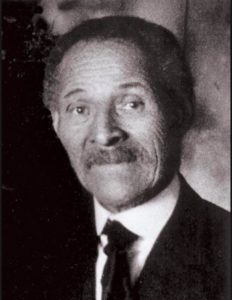
Charles Porter
*This date in 1847 celebrates the birth of Charles Porter, a Black artist who specialized in still-life painting.
Charles Porter was born in Hartford, Connecticut. His father was a mill worker, and his mother was a servant. By the early 1850s, Porter's family moved to the nearby village of Rockville (now part of Vernon, Connecticut). The family suffered many losses when Porter was young. They endured poverty and tragedy just a few years after moving to Rockville. Porter lost seven of his siblings to illness and one to the American Civil War between 1858 and 1868.
Porter's brothers, Joseph and William, enlisted in the Union Army in 1863. Joseph joined the 29th Connecticut Infantry Regiment (Colored), and William joined the 14th Rhode Island Heavy Artillery (Colored). Joseph was killed in Virginia in 1864. William became seriously ill with malaria and was granted a disability discharge in January 1865.
Porter was his family's first child to attend high school, graduating in 1865. Porter left Rockville in 1868 to study painting in Wilbraham, Massachusetts. 1869, after two years of art study at Wesleyan Academy (now known as the Wilbraham & Monson Academy), Porter enrolled at the prestigious National Academy of Design in October 1869, becoming the first Black student admitted to the school. Porter attended the art school until the spring of 1873.
For the first time, Porter began exhibiting his work at the school. A painting titled Autumn Leaves was shown in the school's summer exhibition. In May 1870, Porter was among eight art students whose drawings were given special mention in the New York Times as part of a large school exhibition. Porter received widespread praise and attention for his work during his four years at the National Academy, earning the support of prominent benefactors such as Frederic Edwin Church and author Mark Twain.
In the fall of 1873, Porter studied art with Joseph Oriel Eaton, a prominent portrait and landscape painter, for a year. Every year, he studied and painted in New York City from fall through spring but returned to Rockville in the summer to paint and teach art classes. From 1873 to 1875, Porter started to sell his work. One painting sold for $175, a high price for that time and the artist's experience level. Little else is known about Porter during this period. Art collectors were losing interest in American artists, traveling overseas, and buying contemporary French art and Old Masters. Many young American artists began studying overseas during the economic downturn in the 1870s. Sales by American artists would not recover until the 1890s.
1878, Porter moved to Hartford, Connecticut, and established a studio. The city was experiencing tremendous growth, and its wealthy citizens were interested in art and culture and had the money to begin or add to art collections. Porter's traditional academic art education made him stand out from the many self-taught artists recently moving to Hartford. He was one of the few artists then and the only man specializing in still-life painting. While in Hartford, Porter created many of the still-life paintings he is known for today. Several of his paintings of fruit were not typical of the period, as they did not include tableware, porcelain, and glassware and unusual touches such as insects.
His apple paintings were a commercial success, and he painted apples for much of his career. Porter spent a good deal of time outdoors. He was interested in nature, which is reflected in his paintings of butterflies, dead birds, insects, and plants. In 1879, his work gained the attention of influential landscape painter Frederic Edwin Church. Church visited Porter, purchased a few paintings, and declared Porter to "have no superior as a colorist in the United States." The church encouraged Porter to study and paint landscapes.
1880 Porter visited the Adirondacks for two months, sketching and painting. At the time, he declared that he would focus his work primarily on landscapes, except for commissioned still-life paintings. On March 19, 1881, the Hartford Daily Courant reported that Porter planned to move to Europe for two years to study art. The article stated that Porter would be selling his entire inventory of paintings at auction. Half the paintings sold immediately for $1062; additional sales resulted in $1800.
In early November 1881, Porter sailed for Liverpool. After an art tour of London, he traveled to Paris with letters of introduction from Hartford's most prominent citizens. In Paris, he studied the works of the influential artists of the Barbizon school of painting. He enrolled in the Ecole des Arts Decoratifs, where he studied until 1884 when he ran out of money and returned to Hartford. In December 1884, he hosted an art exhibition and auction of 100 paintings from his time in France.
The Hartford Evening Post praised his new work, but the auction did not attract the attendance or sales Porter had hoped for. In early 1885, Porter returned to New York City and opened a studio. He exhibited his work at the National Academy of Design and continued to paint. He spent the summer of 1885 in Rockville, Connecticut, teaching art and painting landscapes.
By November 1886, Porter was back in Hartford again. He partnered with local artist Daniel Wentworth to hold auctions in 1887 and 1888, Wentworth contributing landscapes and Porter contributing primarily still life—the paintings sold for prices ranging from $6 to $100. By 1889, Porter had left Hartford for the last time. He spent most of the year in New York City and summers in Rockville, Connecticut, until 1897, when he settled permanently in Rockville.
The quality of Porter's work declined after 1900, and interest in his work subsided. Porter, a National Academy of Design in New York City student, was one of the first African Americans to exhibit there. He was the only Black artist who painted in still life at the turn of the 20th century. Charles Porter died on March 6, 1923, at 75.